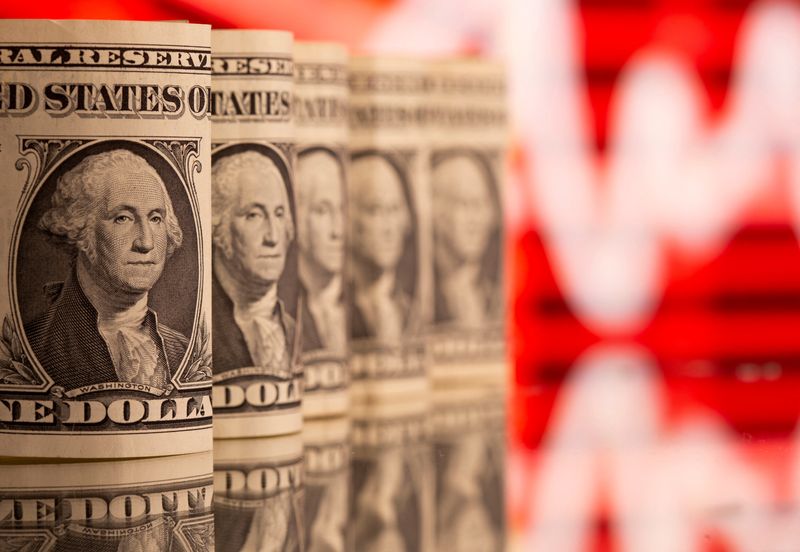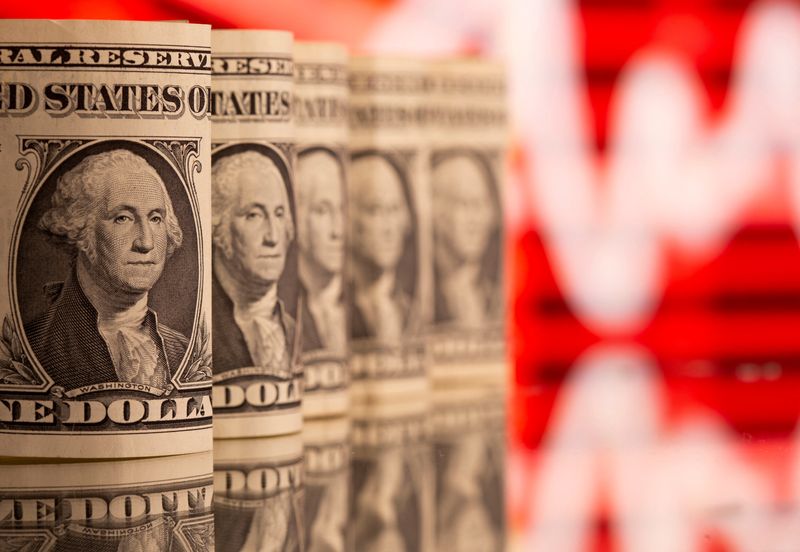Forex
US dollar’s rally supercharged by soaring real yields on Treasuries


© Reuters. FILE PHOTO: U.S. one dollar banknotes are seen in front of displayed stock graph in this illustration taken, February 8, 2021. REUTERS/Dado Ruvic/Illustration/File Photo
By Saqib Iqbal Ahmed
NEW YORK (Reuters) – Surging U.S. real yields are aiding the dollar’s rebound, rewarding bullish investors while making bears think twice before betting against the buck.
The real yield on U.S. 10-year Treasuries – which measure how much investors stand to make on U.S. government bonds after inflation is stripped out – hit 2.47% on Tuesday, the highest in nearly 15 years, according to data from the U.S. Treasury Department.
That has made betting on the U.S. currency more profitable, since bullish investors can collect yield while sitting on their dollar positions. The dollar is up 7% from its 2023 lows against a basket of currencies and stands at a 10-month high.
At the same time, climbing real yields make it more expensive to bet against the dollar. Bearish investors establishing short positions must pay more to borrow the currency.
Dollar positioning in futures markets showed a net long of $3.07 billion for the week ended Sept. 26, according to data from the Commodity Futures Trading Commission. That was a sharp reversal from a short position of $21.28 billion earlier this year.
“The dollar isn’t just the nicest house in a bad neighborhood right now, it’s the only game in town,” said Karl Schamotta, chief market strategist at Corpay in Toronto. With real yields pushing higher, “only the bravest of traders are willing to bet against the greenback,” he said.
The Federal Reserve’s resolve to keep rates higher for longer along with relatively strong U.S. economic growth has helped push nominal yields to their highest level since 2007. That, combined with a deceleration in inflation, has sent real yields soaring.
Their surge has coalesced with other factors to fuel the dollar’s rebound. The greenback is up 3% against a basket of currencies this year.
Other factors include a resilient economy that has made the U.S. a relatively more attractive investment, with growth steadier than floundering Europe and China. The dollar has also gotten a boost from investors nervous about Wall Street’s decline, with the down 7% from its July high.
While U.S. rates have stayed high with growth resilient, “Europe and China have disappointed,” strategists at UBS Global Wealth Management wrote in a recent note.
“The near-term risks are skewed toward additional US dollar strength, in our view.”
The dollar has tracked real yields in recent years, with peaks and troughs closely aligned.
That has made even bearish investors wary of betting against the U.S. currency.
Aaron Hurd, senior portfolio manager at State Street (NYSE:) Global Advisors, said the dollar is overvalued against a broad range of currencies, including the yen, whose sharp decline this year has put investors on the lookout for intervention from Japan’s policymakers.
Still, high real yields make him hesitant to short the U.S. currency.
“I am not going to pay away 5.5-6% a year in interest to short that,” Hurd said.
“You have one of the highest yielding currencies in developed markets. It’s backed by about the strongest growth in developed markets and it provides a hedge to risky assets. That’s kind of a nirvana,” he added.
For now the dollar remains well positioned, Corpay’s Schamotta said.
“A pivot will come – we think relative economic surprise indices will begin shifting against the dollar within the next two months – but for now, the trend is the dollar bull’s friend,” Corpay’s Schamotta said.

 Forex3 years ago
Forex3 years agoForex Today: the dollar is gaining strength amid gloomy sentiment at the start of the Fed’s week

 Forex3 years ago
Forex3 years agoUnbiased review of Pocket Option broker

 Forex3 years ago
Forex3 years agoDollar to pound sterling exchange rate today: Pound plummeted to its lowest since 1985

 Forex3 years ago
Forex3 years agoHow is the Australian dollar doing today?

 Cryptocurrency3 years ago
Cryptocurrency3 years agoWhat happened in the crypto market – current events today

 World3 years ago
World3 years agoWhy are modern video games an art form?

 Commodities3 years ago
Commodities3 years agoCopper continues to fall in price on expectations of lower demand in China

 Economy3 years ago
Economy3 years agoCrude oil tankers double in price due to EU anti-Russian sanctions























